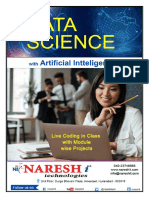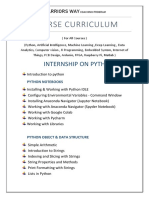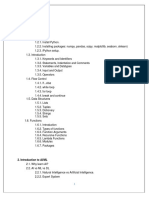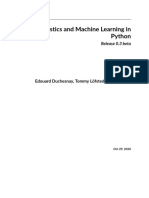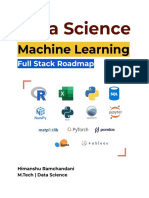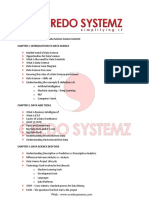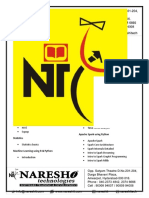0 ratings0% found this document useful (0 votes) 36 views10 pagesData Science & AIML Coursework
Data scientist ekeeda coursework
Copyright
© © All Rights Reserved
We take content rights seriously. If you suspect this is your content,
claim it here.
Available Formats
Download as PDF or read online on Scribd
Become a
Data Scientist
with Ekeeda Pro
>> o aeaes
209.22 b�About
Ekeeda
An Edtech platform facilitating e-learning for engineers, providing career building
ecosystem, driven by a blend of academic, competitive and skill based resources.
a cn ii
10,00,000+ 30+ 10+
Student outreach Careers covered Branches of
Engineering
500+ 45,000+ 9,000+
Courses Videos Hours of
content available
About
Course
Data Science has a major role in the development of an
organisation and its growth. It helps the organisation in
making effective and wise decisions with wide perspective for
the development of the organisation .
It helps in providing practical understanding with
enhancing the organisation's problem solving skills .
We live in a digital world, where everything is
data-driven, therefore we know that analytics is
everywhere. This field of work provides
proficiency with an excellent income Mahesh Wagh,
opportunities . Founder & CEO of Ekeeda
‘©Ekeeda Private Limited�What is the work of a
Data Scientist?
Analyse the past data Design the data
and produce reports models for use in
benificial for business machine learning
Write webservices to be Work on data to
consumed by mobile analyse and predict
apps and websites the future
Train the machine to
act like humans
Technologies
tT Required
Python 3.x
Version control: Git
Python Libraries: Pandas,
Scikit Learn
Machine Learning and
Deep Learning tools:
Tensor Flow, PyTorch, Keras
Databases: RDBMS
(Like MySQL, MariaDB, etc.),
NoSQL (Like MongoDB,
DynamoDB, etc.)
‘©Ekeeda Private Limited�®
Program
Curriculum
@00000000
» Introduction to Python, Python and anaconda Setup
» Basic data types of Python
> Input and Output functions of Python
» Operators in Python » Math Operators
» Comparison Operators » Logical operators
» Control statement if else , for loop, while loop
» List, Tuple, Set and dictionary data type
» Functions in Python » Defining simple function
» Understanding scope of variables
» Variable number of arguments » Positional arguments
» Recursive functions
» Lambda function, Map, Filter, List comprehension
» Back to Functions » Nested functions (Inner functions)
» Understanding locals() and globals()
» Creating and using Modules » Understanding packages
» Classes and Objects
» Operator Overloading » Type conversion
» Containership and Inheritance
» Iterators and Generators
» Exception Handling
‘©Ekeeda Private Limited�o
Program
Curriculum
@
©
‘©Ekeeda Private Limited
» File Input/Output
Industry oriented Case Studies
>» Email Slicer » Desktop Notifier App in Python
Industry oriented Case Studies
» Python Website blocker » Currency converter
» Web Crawler » Music Player in Python
» Random Password generator » Convert Text to
Speech in Python » YouTube Video downloader
» Language translator in Python
» Numpy Introduction » Numerical operations using
Numpy » MatPlotLib Introduction » Plotting various
types of graphs such as scatter plot, line plot,
histogram etc » Pandas Introduction » Handling datasets
and processing data
» Understanding Space and time complexity
» Finding largest and smallest element in a list
» Searching a value using linear search and binary seach
» Merging two sorted lists
» Introduction to Iris dataset » 2D scatter plots
» 3D scatter plots » Pair Plots » Histograms and Probability
density function (PDF) » Univariate Analysis using PDF
» Mean, Median, Variance and standard deviation
» Cumulative distribution function (CDF)
» Percentiles and Quantiles » Box Plots with whiskers
» Violin Plots�Program
Curriculum
@
» Introduction to Vectors » 1D, 2D and nD vectors
» Row vector and Column vector
» Dot product of two vectors » Projection of vector
» Unit vector » Equation of a line, 2D plane and
HyperPlane » Distance of a point from hyperplane
» Equation of circle, sphere and Hypersphere
» Equation of ellipse, ellipsoid and hyperellipsoid
» Square, Rectangle, Cube and HyperCube"
» Probability and Statistics » Population and Sample
» Gaussian Normal distribution and PDF
» Gaussian Normal distribution and CDF
>» Symmetric distribution and skewness.
» Standard normal variate and standardization
» Kernel density estimation
» Sampling distribution and Central limit theorem
> Q-Q plot » Various distributions and their use
» Chebyshev's inequality » Discrete and Uniform
distribution
» Probability and Statistics contd » Bernoulli and Binomial
distribution » Log Normal distribution
» Power law distribution » Box Cox Transform
» Application of non Gaussian distributions
» Co-Variance » Pearson Correlation Coefficient
» Spearman rank correlation coefficient
» Correlation Vs Causation » Use of correlations"�Program
Curriculum
20)
© 9
» Probability and Statistics contd » Introduction of
confidence Interval » Computation of confidence
interval » Hypothesis Testing » Resampling and
Permutation Test » K-S test for similarity of two
distributions » Proportional Sampling"
» Basics of Data Sets » Introduction to dimensionality
reduction » Row and Column Vector » Representation of
Data Set » Representing Data Set as a matrix
» Data Preprocessing » Mean of data matrix » Colum
standardization » Covariance of data matrix
» MNIST Data set » PCA (Principle Component Analysis)
for dimensionality reduction » Limitations of PCA
» t-SNE for dimensionality reduction
» Preprocessing DataSet » Data Cleaning » Convert text
to vector » Bag of words » Stemming » tf-IDF
» Word2Vec
» Classification in Machine learning » K-Nearest Neighbour
» Time and space complexity of K-Nearest neighbour"
» Factors affecting classification algorithms
» Balanced Vs Imbalanced Datasets » Impact of outliers
» Space and Run time complexity » K distance
» Multiclass classification » Time and space complexity
of K-Nearest neighbour » Feature Importance
» Handling categorical and numerical features
» Handling missing values » Curse of dimensionality
> Bias-Variance tradeoff
» Accuracy measure of classification algorithm
» Accuracy » Confusion matrix
» ROC and AUC curve » Log-Loss
» R-squared coefficient of determination
» Median absolute deviation (MAD)
‘©Ekeeda Private Limited�o
Program
Curriculum
® 68 8 066868086
» Naive Bayes algorithm for classification.
» Logistic Regression
» Linear Regression » Gradient descent algorithm
» Support Vector Machine
» Decision tree algorithm for classification
» Ensembles » 140. Random Forest » Gradient boosting
» XGboot and ADAboost"
» Feature Engineering » Moving window for time series
» Fourier decomposition » Image histogram
» Relational data » Graph data » Feature binning
» Feature slicing
» Clustering algorithms » K means algorithm
» K medoid algorithm » Agglomerative clustering
» Density based clustering (DBSCAN)
Hands-on Project
» Project Title: Taxi Demand in your City
» Project Title: Cancer diagnosis�°
Program
Curriculum
©
©
Projects for Self study
> Iris flower classification » Loan Prediction using
Machine Learning » Housing Prices Prediction Project
» Neural network and Deep Learning » History of neural
network and comparison with biological neuron
» Multilayer perceptron » Training a single layer model
» Training MLP model + Back Propagation » Activation
function » Vanishing gradient problem
> Deep layer perceptron » Drop Outs » RELU
» OptimizerHill-descent 2D » OptimerHill-descent 3D
» SGD » Adam optimizer algorithm » Softmax for
multiclass classification » Tensor Flow and Keras
» GPU vs CPU » Google collaboratory"
» Convolutional Networks » Understanding Visual cortex
» Edge detection in images » Padding and strides
» Convolutional layer » Max Pooling » ImageNet data sets
» AlexNet » VGGNet » Mini Project : Cats Vs Dogs
» Given a image of an animal identify whether it is
image of Dog OR Cat OR None
» Recurrent neural Networks + Training RNN model by
backpropogation » Types of RNN » LSTM » Deep RNN
» Bidirectional RNN
Hands-on Project
» Project Title: Self Driving car�Curriculum
» MNIST Digit Classification Machine Learning Project
The MNIST digit classification python project enables
machines to recognize handwritten digits.
This project could be very useful for computer vision.
@ » Emojify - Create your own emoji with Python
The objective of this machine learning project is to classify
human facial expressions and map them to emojis.
» Cartoonify Image with Machine Learning Transform
images into its cartoon. Yes, the objective of this machine
learning project is to CARTOONIFY the images.
Thus, you will build a python application that will
transform an image into its cartoon using machine
learning libraries.
